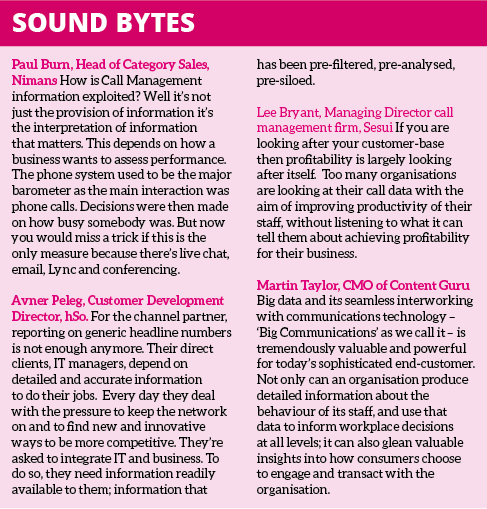
The concept of analysing very large amounts of data and looking within it for patterns, trends, and insights is one that nearly any business, large or small, can use to help make better decisions.
The interesting thing for the channel is that we are used to helping users handle and interpret data – we’ve been doing it for years. The trouble is that we are not really used to selling the concept.
 However, the fact is that the communications platforms we provide customers are a rich source of information that if not gathered and interpreted with insight might just be a waste of time instead of a route to providing more management information and the means of storing it, using it and ultimately, profiting from it.
However, the fact is that the communications platforms we provide customers are a rich source of information that if not gathered and interpreted with insight might just be a waste of time instead of a route to providing more management information and the means of storing it, using it and ultimately, profiting from it.
Take call management – it’s not a window on company activity it’s a double set of doors! But who really exploits this information and how?
Carl Boraman, Commercial Director of Tollring, says that big data for SMEs is all about joining up various sources of data and using it to improve productivity and profitability.
“With accessibility via the cloud, big data enables smaller businesses to take advantage of the tools that were previously only available to larger corporates.
Big data is basically a repository of information drawn from different silos and joined up to make it work more effectively for the business.
A large proportion of Tollring’s iCall Suite end users are SME-sized businesses and we’ve identified five key steps on how an SME can maximise their existing data to make it BIG:
- Define the business objectives
- Identify all sources of data
- Join up the data and consolidate
- Analyse using reports and dashboards to understand the data
- Maximise and use the data to benefit the organisation
Looking at these steps in more detail, the first question is what does the organisation want to achieve from their data? Customer satisfaction is usually a primary aim for SMEs, since a happy customer means repeat business. Customer satisfaction goes hand in hand with an overall aim of using data to improve business productivity and therefore profitability.
 This brings us to the old favourite of First Contact Resolution. A business is doing well if they can deal with a customer’s request quickly and efficiently, compared to asking the customers to repeat their question or query each time they make contact.
This brings us to the old favourite of First Contact Resolution. A business is doing well if they can deal with a customer’s request quickly and efficiently, compared to asking the customers to repeat their question or query each time they make contact.
Secondly, most SMEs will have data stored in a range of isolated areas. The key is to work with what they have and then join it up.
Customer contact information is the best place to start. Most organisations will have a CRM (Customer Relationship Management) system but it can be any database that holds customer details. In addition, a business will have additional stores of information that encompass the many different ways they communicate with their customers:
- Start with the CRM system or a basic database of contacts
- The telephony system tracks all calls made and received
- There may be a separate repository of call recordings
- Access reports from an accountancy system
- Email systems show history of communications
- Social media accounts such as LinkedIn and Twitter provide further data on communications
The phone is still the medium of choice for many people, so call analytics need to be captured and weaved into an organisation’s customer service strategy.
The next step is to join up and consolidate all the sources of information within a single tool.
The SME may select their CRM system to display the combined data. It’s worth noting that few CRM systems are able to access data from the various data repositories, so their service provider will need to recommend an alternative to join up the data. Tollring has inbuilt APIs that can hook into databases and deliver that information to leading CRM systems, many of which are customised to deliver specific workflows for unique vertical sectors.
Next you need to analyse reports and dashboards to understand the data.
 Adding a seamless link to call recordings enables users to hear what was discussed in any conversation. In the past, these recordings would have been held in a separate system and would only be integrated when there was an issue. Now the information can be at hand before an escalation or compliant. It can be used to help employees achieve an understanding of the customer to the highest possible level, which in turn will enable them to deliver better customer satisfaction.
Adding a seamless link to call recordings enables users to hear what was discussed in any conversation. In the past, these recordings would have been held in a separate system and would only be integrated when there was an issue. Now the information can be at hand before an escalation or compliant. It can be used to help employees achieve an understanding of the customer to the highest possible level, which in turn will enable them to deliver better customer satisfaction.
Finally maximise the data based on specific business workflow. This will reveal what customers are expecting and they can access all the available information at the right time.
This helps SMEs to predict customer behaviour and improve their service before they encounter a complaint. Being predictive is how you can excel in customer service and improve processes.
“Big Data is not a term that really relates to or is understood by the majority of SMEs,” says Phil Reynolds, Joint CEO at Oak Innovation.
“The notion of taking data and extracting business intelligence (BI) however is far more valid a concept for the smaller firm. BI has real value for a smaller firm. Generally SME have customer bases of between say 100’s and 1000’s of customers whereas in the Enterprise sized organisation customers counts can often be measured in millions if not billions of users. For Enterprises big data really is BIG!
When it comes to selling it is probably not the best strategy to lead with Big Data as it has a big company corporate feel to it but demand for BI is there driven by the need to increase service and productivity levels.
Here you need to look beyond ‘the longest waiting call’ scenarios as this is both the ‘tip of the iceberg’ as well as being the ‘lowest hanging fruit’ that should have been eaten immediately by addressing the missed call issues as a first pass. With BI I suggest that that firms will be looking to progressively slice away at unproductive activities and improve efficiencies by incremental steps. Today, monitoring agent performance in contact centres with customised measurement and reporting is key to achieving that objective.
Productivity has become far more important for business since the last recession began and as a result reporting is a far bigger issue today than it has ever been as firms seek to optimise their agent and contact centre performance. We therefore sell business intelligence of which just one part is call logging.
So what do you say to a customer if they ask you ‘What information do I get from your communications platform and how can I productively use it?’
Google analytics is a benchmark for next generation reporting – it’s a big data view that has opened up a new vision on data and as result reporting applications have become far more powerful.
Whilst we have made our reporting application easy to use and customise we find at the SME level that companies still ask us to do this for them as a professional service. They want to be assured that the reporting they are getting is as comprehensive as is necessary for a growing company. Corporate and Enterprise firms want the option to pull the data for themselves and put it in to their own systems for analysis.”
Reynolds considers the top three data measurements required by the most SMEs running contact centres today are:
- Service Levels
- Agent Performance
- Lost Call Analysis
Reynolds concludes, “There is increasingly a demand for data modelling by SME’s where ‘what if’ type scenarios can be introduced into reporting to drive immediate performance improvements and future staff planning. This is of course touching on Big Data where modelling and infinite analytic options are part of any solution.”
Ed Says… Big Data – the old adage remains valid – if you don’t measure it you can’t manage it. Productivity increase has become one of the most sought after management measurements for any sized business since the last recession and business information gathering tools, the data and its interpretation is one formula for a secret business success sauce.
